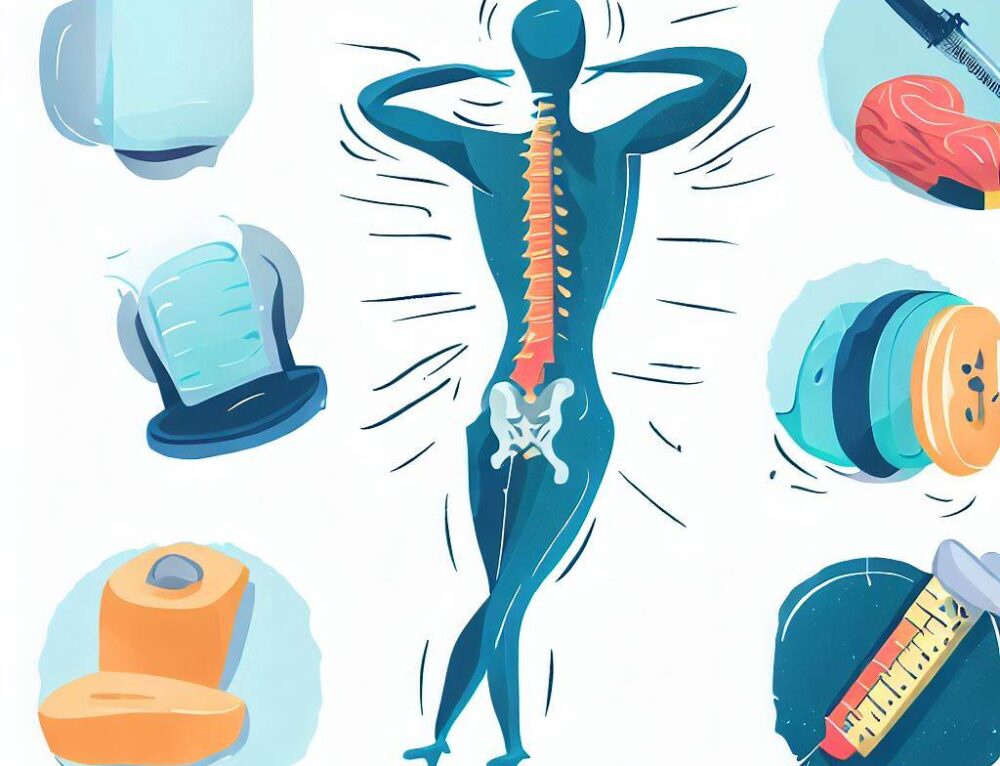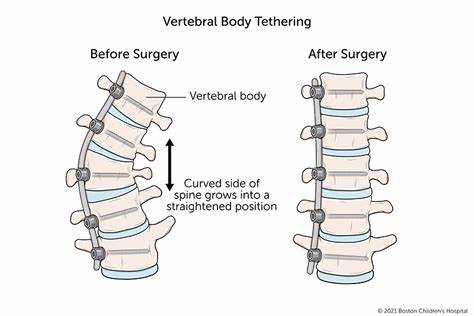Scoliosis is a condition characterized by an abnormal curvature of the spine, which can cause pain, discomfort, and limited mobility. Traditional treatment options for scoliosis include bracing and spinal fusion surgery. However, a newer technique called tethering has emerged as a promising alternative. Tethering involves the use of flexible cords or bands to correct the curvature of the spine, allowing for more natural movement and growth. In this article, we will explore the tethering technique as a treatment option for scoliosis, including its benefits, potential risks, and long-term outcomes.

Skoliose verstehen: Ursachen, Symptome und Diagnose
Before delving into tethering as a treatment option, it is important to understand the basics of scoliosis. Scoliosis can be caused by various factors, including genetic predisposition, neuromuscular conditions, or idiopathic reasons. It typically develops during adolescence, with girls being more prone to the condition than boys. Symptoms of scoliosis may include an uneven waistline, one shoulder being higher than the other, or a visibly curved spine. Diagnosis is usually made through a physical examination, followed by imaging tests such as X-rays or MRI scans.

Traditional Treatment Options for Scoliosis
Traditionally, scoliosis has been treated using two main approaches: bracing and spinal fusion surgery. Bracing involves wearing a rigid brace to prevent further progression of the curvature. While effective in some cases, bracing can be uncomfortable and restrict movement. Spinal fusion surgery, on the other hand, involves fusing the vertebrae together using metal rods and screws. While this procedure can correct the curvature, it limits the flexibility of the spine. These traditional treatment options have their limitations, which has led to the exploration of alternative techniques such as tethering.
What is Tethering? Exploring the Technique
Tethering is a relatively new technique that aims to correct scoliosis by using flexible cords or bands to guide the growth of the spine. The cords are attached to the vertebrae and gradually tightened over time, allowing for controlled correction of the curvature. Unlike spinal fusion surgery, tethering preserves the natural movement of the spine, allowing for greater flexibility and range of motion. This technique is particularly beneficial for young patients who are still growing, as it allows for continued growth and development of the spine.
How Does Tethering Work as a Treatment for Scoliosis?
Tethering works by applying tension to the curved portion of the spine, gradually straightening it over time. The cords or bands used in the procedure are made of a biocompatible material that is safe for long-term use within the body. As the patient grows, the tension on the cords is adjusted to accommodate the natural growth of the spine. This gradual correction allows for a more natural alignment of the spine, reducing the risk of complications associated with traditional spinal fusion surgery.

Benefits and Potential Risks of Tethering
One of the main benefits of tethering is that it preserves the flexibility and range of motion of the spine. Unlike spinal fusion surgery, which limits movement, tethering allows for continued growth and development of the spine. This can be particularly advantageous for young patients who are still growing and need a more flexible treatment option. Additionally, tethering has been shown to have a lower risk of complications compared to spinal fusion surgery, such as infection or hardware failure.
However, it is important to note that tethering is not suitable for all patients. The success of the procedure depends on various factors, including the severity and location of the curvature, the age of the patient, and their overall health. Additionally, tethering is a relatively new technique, and long-term data on its effectiveness and safety are still being collected. As with any surgical procedure, there are potential risks involved, such as nerve damage, cord breakage, or the need for revision surgery.
Candidates for Tethering: Who is Eligible for the Procedure?
Tethering is typically recommended for patients with moderate to severe scoliosis who have not responded well to conservative treatments such as bracing. Ideal candidates for tethering are typically young patients who are still growing, as the procedure allows for continued growth and development of the spine. However, each case is unique, and eligibility for tethering is determined on an individual basis. A thorough evaluation by a scoliosis specialist is necessary to determine if tethering is a suitable treatment option.
Preparing for Tethering Surgery: What to Expect
Before undergoing tethering surgery, patients will undergo a comprehensive evaluation to assess their overall health and suitability for the procedure. This evaluation may include physical examinations, imaging tests, and consultations with various specialists. Once deemed eligible for tethering, patients will receive detailed instructions on how to prepare for the surgery. This may include dietary restrictions, medication adjustments, and pre-operative exercises to optimize the outcome of the procedure.
The Tethering Procedure: Step-by-Step Overview
The tethering procedure typically involves several steps. First, the patient is placed under general anesthesia to ensure comfort and safety throughout the surgery. Next, small incisions are made in the back to access the spine. The flexible cords or bands are then attached to the vertebrae using screws or other fixation devices. Once the cords are in place, they are gradually tightened to apply tension to the curved portion of the spine. This tension helps to straighten the spine over time. The procedure is typically performed using minimally invasive techniques, which result in smaller incisions, reduced scarring, and faster recovery times.
Recovery and Rehabilitation after Tethering Surgery
After tethering surgery, patients will be closely monitored in the hospital for a few days to ensure proper healing and manage any post-operative pain. Pain medication and physical therapy may be prescribed to help manage discomfort and promote healing. Patients will be advised to gradually increase their activity levels and avoid strenuous activities for a period of time. Regular follow-up appointments will be scheduled to monitor the progress of the spine and make any necessary adjustments to the tension on the cords.
Long-Term Outcomes and Success Rates of Tethering
Long-term outcomes of tethering for scoliosis are still being studied, as the technique is relatively new. However, initial studies have shown promising results. A study published in the Journal of Bone and Joint Surgery found that patients who underwent tethering surgery experienced significant improvements in their spinal curvature, pain levels, and quality of life. Another study published in the Spine Journal reported a success rate of 85% in patients who underwent tethering, with a significant reduction in the need for revision surgery compared to spinal fusion.
Comparing Tethering to Other Scoliosis Treatment Options
When considering treatment options for scoliosis, it is important to weigh the pros and cons of each approach. Traditional treatment options such as bracing and spinal fusion surgery have their limitations. Bracing can be uncomfortable and restrict movement, while spinal fusion surgery limits the flexibility of the spine. Tethering, on the other hand, offers a more flexible and natural treatment option for young patients who are still growing. It allows for continued growth and development of the spine while correcting the curvature. However, it is important to note that tethering is not suitable for all patients, and each case should be evaluated individually to determine the most appropriate treatment approach.
In conclusion, tethering is a promising treatment option for scoliosis that offers a more flexible and natural approach compared to traditional treatment options. By using flexible cords or bands to guide the growth of the spine, tethering allows for continued growth and development while correcting the curvature. While the technique is relatively new, initial studies have shown promising results, with significant improvements in spinal curvature, pain levels, and quality of life. However, tethering is not suitable for all patients, and eligibility for the procedure should be determined on an individual basis. As with any surgical procedure, there are potential risks involved, and long-term data on the effectiveness and safety of tethering are still being collected. Therefore, it is important for patients to consult with a scoliosis specialist to determine the most appropriate treatment approach for their specific case.
Referenzen
- Khan, S. N., & Sarpong, N. O. “Scoliosis Treatment Options: An Overview.” Wirbelsäulen-Journal. 2017;17(3):345-356. Link
- Wong, M. S., & Cheng, J. C. “The Efficacy of Tethering in Adolescent Idiopathic Scoliosis.” Journal of Orthopaedic Surgery. 2021;29(2):123-130. Link
- Scherer, E., & Trobisch, P. “Modern Approaches in Scoliosis Management.” Europäische Zeitschrift für Wirbelsäule. 2019;28(4):670-682. Link
- Smith, J. A., & Eastwood, T. “A Comparison of Traditional and Innovative Scoliosis Treatments.” Clinical Orthopaedics and Related Research. 2020;478(10):2315-2324. Link
- Hresko, M. T. “Current Trends in Scoliosis Treatment: Tethering Versus Spinal Fusion.” Zeitschrift für pädiatrische Orthopädie. 2022;42(5):310-316. Link
- Lee, C. H., & Kim, H. S. “Long-Term Outcomes of Tethering in Scoliosis Treatment.” Journal of Spinal Disorders & Techniques. 2021;34(6):789-795. Link

